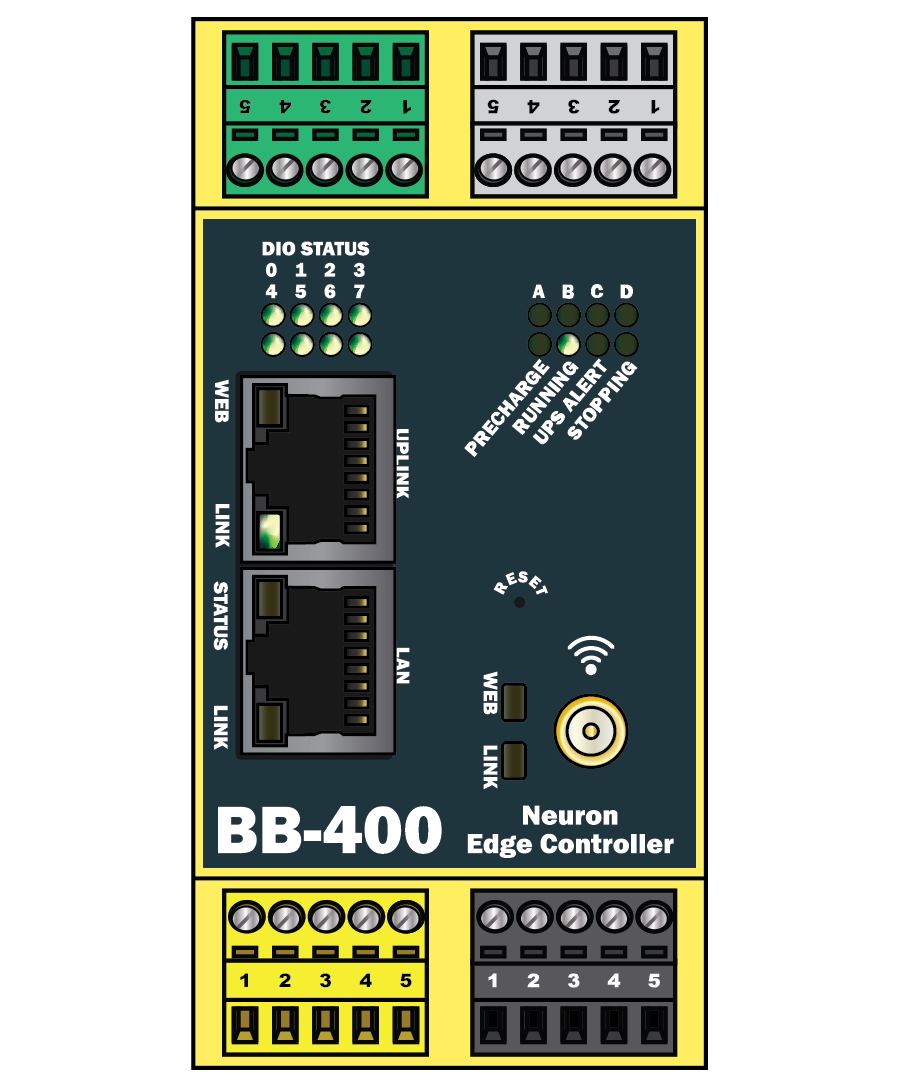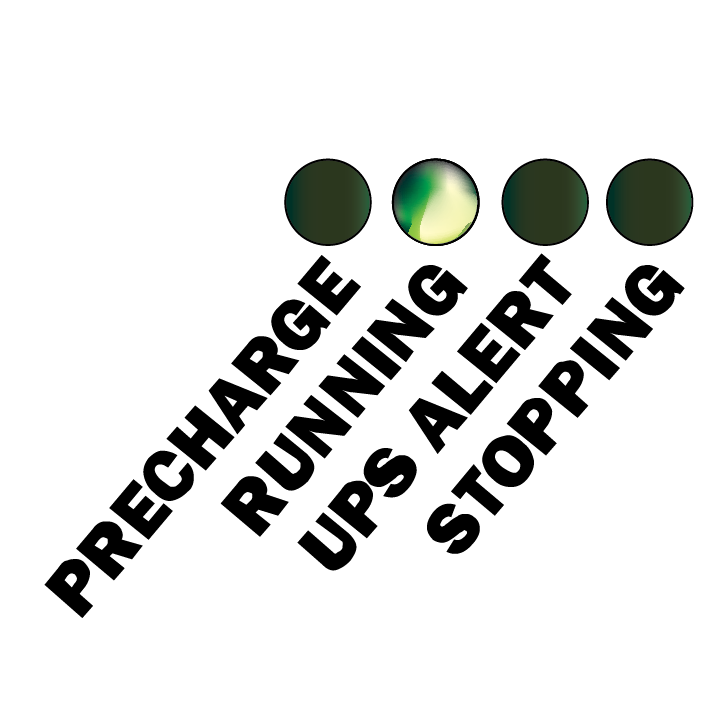FAQs
There are a range of LEDs on the front of the BB-400 device, each providing a physical indication of the state the device is in. This FAQ describes each LED and its corresponding states.
LEDs are useful for debugging and providing an ‘at a glance’ indication of the state of your device. The front of your BB-400 and its LED states are virtualised in the device’s web admin IO page. When you set up your device, a good basic test is to compare the LED states on the device with what you can see on the webpage. If the device is correctly set up, both physical and virtual LEDs will match.
If you make a change to any of the IO line states either on the webpage or with a connection to the device, you should see the LEDs on the device and on the webpage respond.

DIO
The BB-400 has a total of 8 Digital Input/Output lines (DIO for short). Each line can be independently configured to either receive digital inputs or transmit digital outputs. The 8 LEDs on the front face of the device give a physical representation of each DIO line’s state.
By default, the device is set up so that when the voltage is set to high, the LED will be on, and if the voltage is set to low, the LED is off. This way when you first power on the device, you can see all the IO lines are working without having to connect anything. Setting all the IO lines as either NPN or PNP can be done using the jumper inside the case.
(Please refer to the Quick Start Guide for help safely opening the case, and locating the jumper.)
Whatever mode you choose for the device, when the line detects a change it will be reflected by a change in the LED (High > Low or Low > High).
Ethernet Ports
On the BB-400 there are 2 Ethernet ports, named Uplink/Eth0 and LAN/Eth1, where LAN stands for local area network. Each has a pair of LEDs located at the bottom of the port that are used to identify different port states. Each port is different however, as outlined below.
-
Uplink
Both of the LEDs on the Uplink port are labelled as Link and Web, each providing different information depending on the LED’s state. The Link LED has 3 states, if the LED is off then it is not connected to a network, likewise if the LED is on then it has a network connection. If the LED is flashing then there is data activity currently occurring on that port.
Additionally, there is a ‘Web’ LED: if the LED is flashing it is checking for an internet connection (it does this every 1 minute) and if the LED is off then the device has no internet connection.
-
LAN
Like the Uplink port, the LAN port also has labelled LEDs, however they are called Link and Status respectively. In addition, similarly to the Uplink port, both of the LAN port LEDs give different status information for the port. The Link port has 3 states. If the LED is off then the device is not connected to a LAN port, and if the LED is on then it is connected to a LAN port. Likewise, if the LED is flashing then the port has data activity occurring at that time.
The status on the LAN port acts much differently to the Web LED on the Uplink port. Similarly to the Web LED, it too has 2 states. If the LED is on then the BB-400 is connected to a 100Mbps network connection, and if the LED is off then the BB-400 is connected to a 10Mbps network connection.
Wi-Fi Antenna
Aside from the 2 Ethernet ports, the BB-400 also has a wireless antenna, which is capable of providing both wireless and Bluetooth interaction with the device. Also, like the 2 Ethernet ports, it has 2 status LEDs, called Web and Link.
The table below describes the status of the Wi-Fi Link and Wi-Fi Web LED depending on the radio status:
| Radio | Status | Wifi LINK | Wifi WEB |
|---|---|---|---|
| wifiap | ON | Flashing | Flashing |
| wlan0 | ON – not connected to an AP | Flashing | Off |
| wlan0 | ON – new AP discovered | Flashes twice | Flashes twice |
| wlan0 | ON – connected to an AP | On | Flashing – when checking for internet access |
| wlan0 | ON – connected to an AP | On | On – when internet access is available |
| wlan0 | ON – connected to an AP | On | Off – if no internet access |
| wifiap [&] wlan0 | OFF | Off | Off |
LEDs labelled A-D
There are 4 LEDS, A, B, C, and D that correspond to:
-
Admin
The first LED on this row, represented by the letter A, corresponds to the Admin LED. This LED will be on when the BB-400 is powered on and the user is running an active session.
-
NFC
The Near Field Communication (NFC) LED, labelled B, is currently not available, but will be enabled soon via a software update.
-
Serial
The serial LED on the front of the BB-400, indicated by the letter C, is used to signal that there is serial data being transmitted through the BB-400, either in or out.
-
Bluetooth
The Bluetooth LED, labelled D on the front of the BB-400, is used to signal that the device has a Bluetooth connection.
Power Management
Below the LEDs labelled A-D, the BB-400 has 4 LEDs relating to the power state: precharge, running, UPS alert and stopping.

-
-
Precharge
The precharge LED is linked to the PMU, or Power Management Unit, and is used to signify that the device is currently in the precharge state. The device is in this state when it is first powered on, and the initial 5 seconds after powering on are used to charge the internal super capacitors. This is necessary in the event of power loss to supply the device with enough electricity to safely shut down the Raspberry Pi module without causing it any damage.
-
Running
The running LED is the most likely to be seen active. When this LED is on, it is indicating that the device is functioning and ready to be used. In addition, if the device is powered and this LED is not flashing it could indicate that there is a fault with the device.
-
UPS Alert
Uninterruptible Power Supply Alert or UPS Alert is a safety measure on the BB-400 used to preserve the Raspberry Pi compute module inside. The Raspberry Pi module is known to have serious issues regarding data loss when power is suddenly cut. The UPS was implemented as a way of ensuring if the device does lose power there is enough internal storage to safely shut down the Raspberry Pi module without losing or corrupting data.
-
Stopping
The stopping LED indicates that the BB-400 has reached its lower threshold for power supply input and typically indicates that the device has lost all power input. In this case, it begins to shut down the device, cutting off supply to all unnecessary components giving the Raspberry Pi enough charge to shutdown correctly.
-
